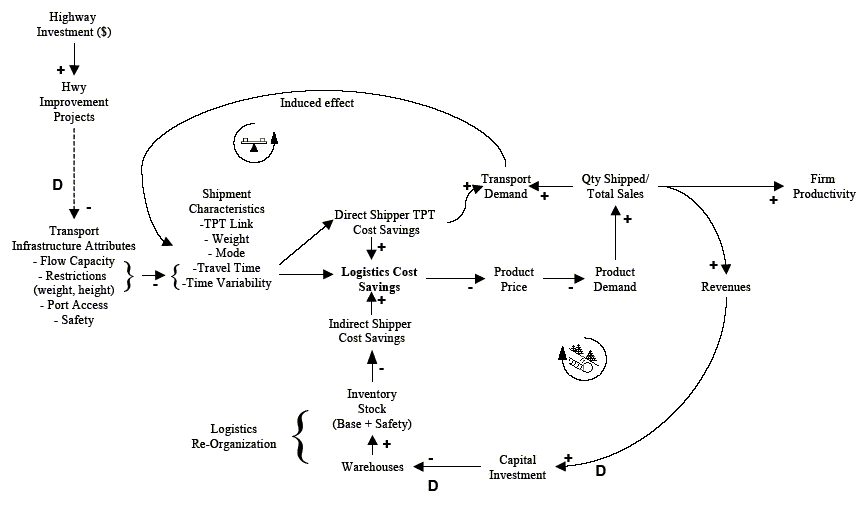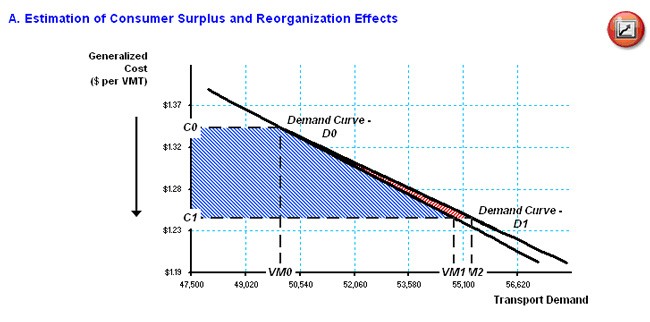Highways and the Economy Microeconomic and Industry Analysis Office of Transportation Policy
Post on: 16 Март, 2015 No Comment

Economic Industry Analysis
The first area of industry analysis, EIA, examines how the direct benefits of an infrastructure improvement project, such as timesavings and greater reliability, impact a local, regional or national economy. The EIA may include local or regional business activity, tourism, and housing. This type of research stands in contrast to benefit-cost analysis (BCA) that examines the direct benefits and costs of a transportation project on users and nonusers.
Clifford Winston and Chad Shirley conducted the first research under the EIA initiative by examining the effects of transportation investments on firms’ inventory and logistics costs. The results of this work were published in a paper Firm Inventory Behavior and the Returns from Highway Infrastructure Investments (2003). A revised version of this paper was published in the Journal of Urban Economics (2004). Winston and Shirley use an inventory-theoretic Economic Order Quantity (EOQ) model to evaluate the linkage between business costs and infrastructure investment absent from macro-econometric studies. The Winston and Shirley theoretical model links cost, speed, and the reliability of freight transportation services with the firm’s cost-minimizing inventory levels and total logistics cost. The results show that rates of return exceeded 15 percent during the 1970s but that returns fell to less than 5 percent during the 1980s and 1990s.
The Economic Industry Analysis research then turned to examine the impact of road congestion on business costs. Despite a number of engineering based assessments of road congestion through the 1990s, such as the Urban Mobility Report by the Texas Transportation Institute, FHWA found that surprisingly little was known about how, and to what extent, road congestion impacts business costs. To plug the gap, FHWA asked Winston and Shirley to build on their earlier work in examining the effects of road congestion on business logistics. Presented to FHWA in 2004, their paper The Impact of Congestion on Shippers’ Inventory Costs (FHWA to add link) estimates congestion costs for shippers using 3 separate methodologies. One methodology follows the model presented in Firm Inventory Behavior and the Returns from Highway Infrastructure Investments. the second is based on Texas Transportation Institute data, and the third is based on the FHWA’s Freight Analysis Framework. The three methods yield consistent results, suggesting that the annual costs of congestion are roughly $7 billion. a substantial sum in absolute terms and relative to independent assessments of the cost of congestion to motorists in urban areas.
www.fhwa.dot.gov/policy/otps/valuepricing.htm .
Strategic Multimodal Analysis
The second area of industry analysis, strategic multimodal analysis integrates several FHWA tools to measure the impact of alternative freight transportation investments or subsidies. The SMA focuses on developing tools and analysis for national or broad corridor impacts and investments. One of the initial products from this analysis is An Initial Assessment of Freight Bottlenecks on Highways that categorizes and measures the leading national bottlenecks impacting roadway freight shipments.
www.fra.dot.gov/us/content/1543 ) and other models developed as part of the Highway Cost Allocation and Comprehensive Truck Size and Weight Study.
The SMA employs a scenario-based analysis to examine alternatives of: highway expansion; exclusive truck lanes; urban truck bypass routes; rail intermodal investments; and maritime intermodal investments. The models and data are being developed for the Chicago New York corridor. Following development, testing, and reporting the SMA model will be expanded for national analysis.

Additional Industry Analysis at FHWA
FHWA’s Office of Freight Management and Operations (HOFM) have sponsored research to revisit the usefulness of benefit-cost analysis to measure improvements in freight transportation using traditional BCA. Specifically, HOFM wanted to estimate the benefits and costs, including benefits to shippers, of investing in improvements in intermodal links between the highway system and railroads, ports, and airports as well as in highway corridors where significant volumes of freight moved. Until then most BCA research had focused on user benefits for highway passengers and truck operators alone, neglecting general freight industry effects. These more general effects include shorter delivery times, more reliable scheduling, and the ability to reduce both inventory levels and the number of storage/distribution locations. HOFM is developing an analysis tool to capture the full benefits and costs of freight transportation improvements. To develop a benefit-cost model to capture these effects the Office of Freight Management sponsored research by a group of economic consultants published in a number of reports.
Phase I of the study is documented in three reports completed in early 2001: (1) Freight Benefit/Cost Study: Compilation of the Literature ; (2) Benefit-Cost Analysis of Highway Improvements in Relation to Freight Transportation: Microeconomic Framework ; and (3) Capturing the Full Benefits of Freight Transportation Improvements: A Non-Technical Review of Linkages and the Benefit-Cost Analysis Framework. The reports present a microeconomic framework to measure freight-related economic benefits and costs of highway infrastructure projects. A key objective of the model is to capture the benefits of changes in logistics systems resulting from highway infrastructure improvement. They argue businesses will reorganize themselves to take advantage of infrastructure investment by substituting transportation and just-in-time deliveries for larger inventories and multiple warehouses. These logistics advancements are likely to result in increased productivity of the economy as a whole. The study attempts to quantify the benefits of industry reorganization.
ops.fhwa.dot.gov/freight/freight_analysis/econ_methods.htm .














